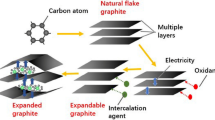Abstract
The electrochemical synthesis of graphite bisulfate in 94% H2SO4 is studied in galvanostatic (I = 10 μA) and potentiostatic modes. The formation potentials and detailed chemical formulas of stage I–V graphite bisulfate are determined. It is found that, within the stability range of a given stage, the molar ratio of intercalated H2SO4 to HSO– 4 varies slightly. This variation is more significant at larger stage indices. In a potentiostatic mode, ordered stage I–V graphite bisulfate can be synthesized, with reproducible chemical and phase compositions. It is shown based on rough estimates of the diffusion coefficient D of sulfuric acid in the graphite host that the intercalate layer is indeed in a “quasi-liquid” state: the estimated D is substantially lower than typical diffusivities in solids. The thermal properties of stage I–V graphite bisulfate are studied systematically for the first time. It is found that, independent of the stage index, graphite bisulfate decomposition results in an unresolved endothermic doublet in the range 170–340°C. Heating to 170°C leads to partial decomposition of the graphite intercalation compounds, accompanied by an increase in stage index by unity. As a result, sulfuric acid is present in two states: free (deintercalated) and bound (in graphite bisulfate). The lower temperature endotherm in the unresolved doublet is due to the vaporization of free H2SO4 , and the higher temperature endotherm is due to the deintercalation and vaporization of bound sulfuric acid. The estimated heat of deintercalation from stage I–V graphite bisulfate (2.9–0.5 kJ/mol C) decreases steadily with increasing stage index.
Similar content being viewed by others
REFERENCES
Bottomley, M.J., Party, G.S., Ubbelohde, A.R., and Young, D.A., Electrochemical Preparation of Salts from Well-Oriented Graphite, J. Chem. Soc., 1963, pp. 5674–5680.
Metrot, A. and Fischer, J.E., Charge Transfer Reactions during Anodic Oxidation of Graphite in H2SO4, Synth. Met., 1981, vol. 3, no. 3, pp. 201–207.
Fujii, R., Graphite Bisulfate Intercalation Compounds, Osaka Koge Gijutsu Shikenze Hokoku, 1978, vol. 353, pp. 1–66.
Monyakina, L.A., Avdeev, V.V., and Nikol'skaya, I.V., Calorimetric Determination of the Enthalpy of H2SO4 Intercalation into Graphite, Izv. Akad. Nauk SSSR, Neorg. Mater., 1990, vol. 26, no. 4, pp. 760–761.
Furdin, G., Exfoliation Process and Elaboration of New Carbonaceous Materials, Fuel, 1998, vol. 77, no. 6, pp. 479–485.
Alfer, S.A., Skoropanov, A.S., Vecher, A.A., et al., High-Temperature Investigation of Raw Material for Thermally Exfoliated Graphite (TEG) Production and Study of the Thermophysical Properties of TEG Products, Thermochim. Acta, 1985, vol. 88, pp. 489–492.
Leshin, V.S., Sorokina, N.E., and Avdeev, V.V., Graphite Intercalation in H2SO4-CH3COOH Electrolytes, Neorg. Mater., 2003, vol. 39, no. 8, pp. 964–970 [Inorg. Mater. (Engl. Transl.), vol. 39, no. 8, pp. 826–832].
Galus, Z., Teoreticzne podstavy elektroanalizu chemiczne, Warsaw: Państwowe Wydawnictwo Naukowe, 1971. Translated under the title Teoreticheskie osnovy elektrokhimicheskogo analiza, Moscow: Mir, 1974, p. 552.
Dobo, D., Electrochemical Data, Budapest: Akadémia Kiadó, 1978. Translated under the title Elektrokhimicheskie konstanty, Moscow: Mir, 1981, p. 367.
Petrov, S.G., Skoropanov, A.S., and Vecher, A.A., Physicochemical Properties of Layered Graphite Compounds, Usp. Khim., 1987, vol. 56, no. 8, pp. 1233–1252.
Chebotin, V.N., Khimicheskaya diffuziya v tverdykh telakh (Chemical Diffusion in Solids), Moscow: Nauka, 1989, p. 208.
Author information
Authors and Affiliations
Rights and permissions
About this article
Cite this article
Leshin, V.S., Sorokina, N.E. & Avdeev, V.V. Electrochemical Synthesis and Thermal Properties of Graphite Bisulfate. Inorganic Materials 40, 649–655 (2004). https://doi.org/10.1023/B:INMA.0000032001.86743.00
Issue Date:
DOI: https://doi.org/10.1023/B:INMA.0000032001.86743.00




